
Crimping versus clamping hose assemblies
By Brent Stone National Hose
Features Tech tipsFor centuries, hose distributors have been attaching fittings and couplings to hoses with methods that date back to our ancestors. Back when the only hoses around were leather ones used on the fire department wagon, wire was used to keep the original pin lug coupling in the hose.
 Clamped assemblies will just about always leak eventually. For centuries
Clamped assemblies will just about always leak eventually. For centuriesFinally, in just the last 20 years, we have moved beyond such antiquated technology. Today’s innovation uses crimp-specific industrial hose fittings, couplings, ferrules and sleeves, creating permanently attached fittings to hoses for a 100 per cent leak-free assembly. Gone are the days when a distributor would use a hodge-podge of different manufacturers’ products banded together and hope for some level of performance. Safety and liability were laid solely with the distributor assembling the hoses and end users expected that leaking and failure were inevitable.
A need in our industry for better performing hoses – ones that would be safer for end users and increase process efficiency – was evident. Crimpnology provided hose distributors with the product innovations and the crimping system to create hose assemblies that would perform under higher pressures, higher temperatures, and not leak while in service. Today, crimped hose systems are becoming much more common than the traditional banded or bolted assemblies we all grew up with – but don’t be fooled, all crimped hose assemblies are not the same!
A hose assembly is made up of three components: the hose, a fitting or coupling, and an attachment method. The overall rating of such an assembly must be rated to the lowest component. For example, if a jackhammer hose has 300 psi printed on the layline as a working pressure and uses a universal coupling (a.k.a. Chicago coupling), there is already an issue. Disregarding the attachment method for a moment, the universal coupling is only rated to 150 psi. Therefore, labeling the entire assembly 300 psi is a mistake. Using this hose in a 300 psi application would be unsafe and could potentially cause an accident. Now add in the factor of clamping the universal coupling on to the hose. The sum of those three components would be zero. Why? Because clamping a fitting or coupling on to a hose does not create a permanent attachment. Therefore, you cannot assign a clamped assembly a pressure rating. The question becomes: how tight is tight enough for a pre-formed clamp? Clamping just not a repeatable way to attach fittings and couplings to hoses and will not ensure industry-mandated safety factors are met consistently.
Using today’s innovative technology, hose distributors can now create hose assemblies using fittings and couplings specifically engineered to be crimped with pre-calculated specs provided by the manufacturer, thereby creating permanently attached, leak-free hose systems. These hose systems can be assigned a pressure rating which carries a minimum safety factor, designated by the National Association for Hose and Accessories Distribution’s Hose Safety Institute. Pressure ratings vary greatly from fitting to fitting, also taking into account the type of hose construction and the specific attachment method. For example, a sleeve will have less holding power on a hose than a ferrule, because a ferrule creates a mechanical interlock with the fitting, allowing for higher pressures to be achieved while in service. Also, older coupling serration designs do not allow for crimping. The old style, two-bump cam-and-groove was designed to be banded, not crimped. NAHAD recommends using newer fitting technology that employs multiple serrations throughout the length of the shank, which maximizes sealing and retention.
The process of crimping sleeves and ferrules on to hoses is surprisingly straightforward. However, not having the appropriate type of components or failure to follow a process mandated by the manufacturer may generate poor results. A procedure of hose measurement will guide the distributor in using an industrial hose crimper to squeeze the ferrule or sleeve on to the hose to a pre-calculated specification. Verifying that the final crimp is to within the manufacturer’s tolerance range is critical to success. Only after completing all the necessary steps can a distributor be confident that a hose assembly will perform to the manufacturer’s published pressure ratings.
Other application factors that will affect the performance of the hose assembly, such as elevated temperature (of either the media or the environment) will also be critical to the understanding and expectation of what a particular assembly can and can’t do. Please refer to a reputable and trusted hose distributor, with all of the pertinent STAMPED data, in order to ensure proper identification of an application and what the safest and most efficient hose and fitting combination is. STAMPED data is an acronym that encompasses all the information related to a specific application – Size, Temperature, Application, Media, Pressure, Ends, and Delivery.
Crimpnology, it’s not just crimping
As the industrial hose markets continue to demand better performing, more reliable hose systems, critical applications have seen the most success. Those applications that involve steam, high-pressure air, chemical transfer or other higher pressures and temperatures have quickly seen the value of increased safety and process improvement. When a failure occurs with these applications, people may often be injured. But what about the other negative effects, such as costs related to clean-up, property and environmental damage, process downtime, even fines or shutdowns. In a world dominated by liability, you cannot afford an accident.
But what about those less critical applications? Even those applications with lower pressures like water suction and discharge have embraced the benefits of crimping technology. Some may say that a jackhammer hose is not dangerous. Have you ever seen one whipping around a job site? Ever known someone to be injured by one? Even water transfer can create headaches in places where leaking is unacceptable. Crimping on layflat and mill hose solves the problem of continually leaking banded assemblies. Plus, no more clamp buckles to cut the operators’ hands or gloves. Mounting process costs apply to these applications as well when hoses don’t perform as needed.
Training is also a large part of creating successful crimped assemblies. Without a clear understanding of how to properly assemble and crimp the correct hoses for the right applications, failures can still happen. Just because a company says they can crimp hose, doesn’t mean they have the education or the commitment to crimp responsibly. Be thorough when assessing a hose distributor to crimp hoses for your application.
While the investment in an industrial crimper is significant, the cost of crimpable fittings, ferrules and sleeves is not unreasonable. There is always a cheaper option available somewhere. But the true savings are realized by not having a failure. It’s the challenge of price versus cost. Of course a cheaper price sounds great in the short term, but what are the hidden costs of a failed assembly? What about the loss of one’s reputation? As the old adage goes: if you think safety is expensive, try an accident.
Hose assemblies that are leak-free, perform under pressure and get the job done is the ultimate goal. The proof of how an assembly will perform is in the testing. Only premier manufacturers can stand by the performance of their fittings and couplings. A common problem is the pressure ratings (sometimes only recommendations) that some companies publish. Typically, those ratings only refer to the fitting or coupling itself. However, these are hose fittings, meaning they aren’t any good without attaching them to the hose in some fashion. A banded hose has no pressure rating. However, a bolt-clamped assembly can carry a rating, but only when the clamp is torqued to the manufacturer’s specifications. Any loosening or over-tightening of these bolts negates that rating. According to most manufacturers, bolt clamps need to be re-tightened after every use. That means every day. So the assembly you just bought and paid for probably already needs to be re-tightened by the time you take delivery of it. Over time, the application pressures, thermal-cycling and environmental factors can lead to the continual loosening of bolts on a clamp and create leaking and poor hose performance. Without re-tightening, leaking will continue to become worse and eventually lead to a fitting ejection.
Crimpnology creates a permanent attachment between the fitting and the hose for a leak-free assembly. Then pressure ratings are assigned based on both the fitting and the attachment (ferrule/sleeve). Only through extensive burst testing can a manufacturer or distributor truly stand behind their ratings and product. This testing is also the basis for creating and verifying the crimp specs that the distributor uses to crimp each assembly. No guesswork here, just science!
Print this page
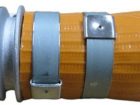
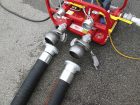
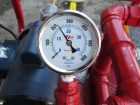
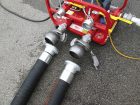
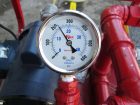
Leave a Reply